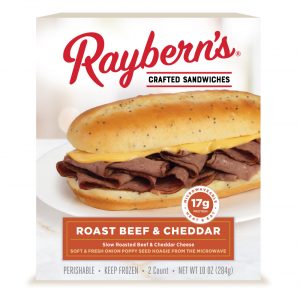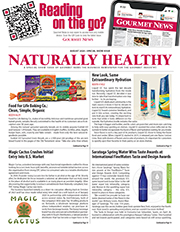Impossible Beef Hot Dogs to Debut for 1 Day Only in NYC
 On Saturday, Dec. 16, Impossible Foods will debut an exclusive sneak preview of its latest meat-from-plants innovation – all-new Impossible Beef Hot Dogs – available for one day only in New York City.
On Saturday, Dec. 16, Impossible Foods will debut an exclusive sneak preview of its latest meat-from-plants innovation – all-new Impossible Beef Hot Dogs – available for one day only in New York City.
As hungry holiday shoppers descend on Midtown Manhattan in search of the perfect gifts, Impossible will be serving up a gift of its own: free Impossible Hot Dogs on Dec. 16 from 11 a.m. to 6 p.m. Impossible fans can tune into the brand’s Instagram page for the address drop in the days leading up to the event.
The giveaway marks the first taste of Impossible’s newest product, which promises a fresh but familiar take on the classic American hot dog and is set to launch in restaurants and grocery stores next year. The juicy, savory links offer a similar cooking and sensory experience to traditional animal beef hot dogs, but are made with high-quality ingredients derived from plants.
Impossible Hot Dogs outperform the animal on several key nutritional metrics: they contain 50% less total and saturated fat than a leading brand of animal beef hot dog served in restaurants, in addition to featuring a whopping 12 grams protein (versus 6 grams) and 0 milligrams cholesterol.2 Unlike most animal-based hot dogs, the franks also contain no added or synthetic nitrates or nitrites, instead using only those naturally occurring in cultured celery powder.
“Hot dogs are an undeniably classic part of American culture and not to mention, they’re a burger’s best friend. It’s long been a priority to add them to our product portfolio,” said Peter McGuinness, CEO and President of Impossible Foods. “Our adaptation replicates that quintessential hot dog taste, while offering consumers a nutrient-dense product that’s better for the planet. We want people to see that there’s really no compromise when you choose Impossible products. It’s as easy as throwing an Impossible Hot Dog on the grill – right next to an Impossible Burger.”
The craveworthy, nostalgia-inducing hot dogs cook up just like their animal beef counterparts and are primed for a variety of delicious toppings – from classic condiments like ketchup or mustard, to plant-based Impossible Beef Chili. And because they’re made from plants, Impossible Hot Dogs account for 84 percent less greenhouse gas emissions, 77% less water and 83 percent less land than an animal beef hot dog.
Impossible Hot Dogs mark the seventh new product to be released by Impossible in the last 12 months. Earlier this year, the company doubled-down on its beef-from-plants portfolio with the Impossible Indulgent Burger – a gourmet patty that recently rolled out across Ruby Tuesdays nationwide – and Impossible Beef Lite – a heart-healthy, plant-based take on lean beef. Impossible also expanded its chicken-from-plants portfolio with new offerings like Impossible Spicy Chicken Nuggets & Patties and Impossible Chicken Tenders. Meanwhile, its flagship Impossible Beef product remains the top-selling plant-based meat product in the United States by dollar sales and volume, across both the retail and foodservice sectors, and its Impossible Meatballs are the #1 best-selling plant-based meatball in the United States.
For more news of interest to the specialty food industry, subscribe to Gourmet News.
Raybern’s Rebrands Packaging, Revamping Deli Sandwich Line
 Raybern’s, a brand known for offering authentic deli-style Philly Cheesesteak sandwiches, kicks off a rebrand not only in package design, but in terms of quality, quantity and variety of sandwich ingredients. Beginning Q1, 2024, Raybern’s will introduce a revamp of its entire line, offering unique flavors and formats that are designed and created to thrill discerning sandwich lovers everywhere.
Raybern’s, a brand known for offering authentic deli-style Philly Cheesesteak sandwiches, kicks off a rebrand not only in package design, but in terms of quality, quantity and variety of sandwich ingredients. Beginning Q1, 2024, Raybern’s will introduce a revamp of its entire line, offering unique flavors and formats that are designed and created to thrill discerning sandwich lovers everywhere.
Five delicious Raybern’s varieties will be available in 2-ct packs to consumers at an SRP of $5.79, and sold in freezer cases everywhere.
Raybern’s introduces new and innovative recipes to their full line of mouthwateringly savory sandwiches. Notably, the Roast Beef & Cheddar sandwich is now complemented with a soft, poppy seed roll. In addition, Raybern’s is relaunching their Ham & Cheese sandwich, enhanced by a sweet deli roll.
The rest of the line has been upgraded with delectable meats, cheeses and sauces, including the Philly Cheesesteak, Chicken Bacon Ranch and Barbecue Pulled Pork. In this complete brand overhaul, Raybern’s is ensuring that frozen food consumers don’t have to compromise when they walk down the freezer aisle.
“Our new sandwich line up is a totally delicious innovation on sandwiches of the past,” shares Doug Hall, director of marketing at Raybern’s. “We have the bakery-soft bun covered, but we’ve completely amped up the meats, cheeses and sauces on our favorite frozen deli-style sandwiches! My personal favorite is the Roast Beef & Cheddar now on a fresh poppy seed roll.”
When it comes to sandwiches, Raybern’s has proven to be a brand that knows how to bring amazing flavor from the freezer to the microwave. Over 30 years ago, the founders Ray and Bernie envisioned sharing their love of New York-style deli sandwiches with the world. It took years to fully develop the Raybern’s bread recipe that cooks up “Bakery Soft” right from the microwave – as well as their signature Philly Cheesesteak recipe.
Today, Raybern’s is proud to make millions of sandwiches each year, including the best-selling Philly Cheesesteak in America, according to 2023 Nielsen Scan Data. Now, the brand introduces bigger and better sandwiches to continue giving consumers what they crave.
Raybern’s believes that the New York-style deli sandwich reigns supreme. Since 1978, they have been crafting incredibly delicious sandwiches with bakery-soft bread, slow-roasted meats and chef-created sauces. Now, consumers can enjoy authentic deli goodness at home or while on-the-go. It is Raybern’s mission to share its love of great sandwiches with as many people as possible and ensure that sandwich lovers don’t need to compromise in the freezer aisle.
For more new products in the specialty food industry, subscribe to Gourmet News.
Giant Food, Shady Brook Farms Donate 11K Turkeys to Food Banks
Giant Food, the leading greater Washington, D.C. regional grocery chain, has announced its annual holiday turkey donations. In partnership with Shady Brook Farms, Giant Food will be donating 11,000 turkeys to its local Feeding America food banks partners as well as local organizations including Martha’s Table, Men Aiming Higher, THEARC: Building Bridges Across The River, Greater Washington Urban League and Greater Baltimore Urban League. Since 2011, Giant has donated 62,000 turkeys during Thanksgiving and this year, Shady Brook Farms is generously providing additional turkeys to make an even larger impact.
“At Giant, fighting food insecurity in the communities we serve is one of our top priorities,” said Dyani Hanrahan, vice president of marketing and community relations, Giant Food, and Maryland Food Bank board member. “We are proud to support over 20 community organizations this Thanksgiving in partnership with Shady Brook Farms to make sure our neighbors in need enjoy their holiday celebrations with family and loved ones.”
“At Shady Brook Farms, we take great responsibility in not only giving back during the critical holiday season, but also throughout the year to ensure families and local communities have access to delicious and nutritious meals,” said Hannah Kern, Shady Brook Farms marketing manager. “Partnering with a like-minded organization such as Giant Food to provide turkeys to those in need is incredibly meaningful and we’re beyond appreciative of their collaboration on impactful initiatives such as this.”
Additionally, Giant launched the annual “Lend a Hand for Hunger” campaign to benefit five area Feeding America food banks – Capital Area Food Bank, Maryland Food Bank, Food Bank of Delaware, Fredericksburg Regional Food Bank and Blue Ridge Area Food Bank – and other area nonprofits.
The campaign, running from Oct. 27 to Dec. 31 in all 164 Giant stores, offers customers an opportunity to support their neighbors by rounding up their change to the nearest dollar amount during checkout in-store or selecting a donation of $1, $3 or $5 during checkout in-store or online. Last year, through the generous support of associates and customers, over $1 million was raised to fight food insecurity.
For news of interest to the grocery industry, subscribe to Gourmet News.









